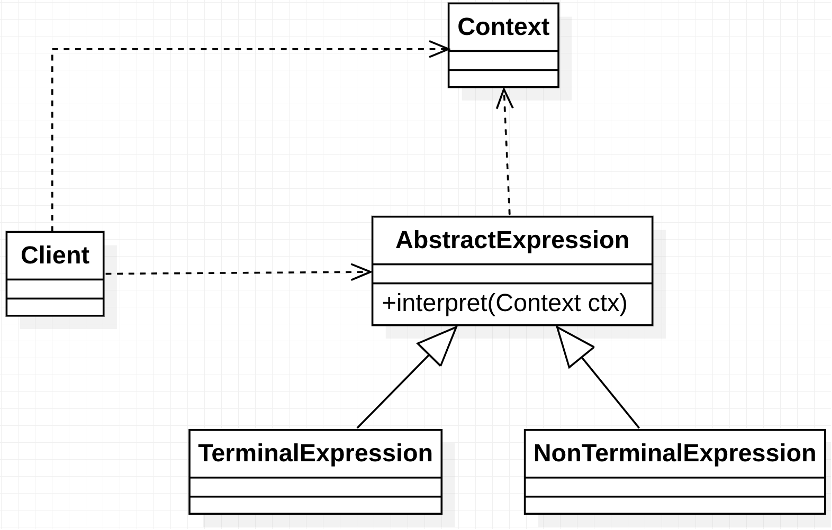备忘录模式是用于保存对象在某个时刻的状态,来实现撤销操作。而解释器模式则是将文本按照定义的文法规则解析成对应的命令。
1 备忘录模式
需求:保存对象在某个时刻的状态,后面可以对该对象实行撤销操作。
1.1 备忘录模式介绍
提供一种状态恢复机制,在不破坏封装的前提下,捕获对象内部状态并在该对象之外保存这个状态。可以在以后将对象恢复到原先保存的状态。

图 备忘录模式 UML
public class MementoPattern {
public static void main(String[] args) {
String[] colors = {"red","blue","green","pink","black"};
Button button = new Button();
Random random = new Random();
MementoCareTaker<ButtonMemento> careTaker = new MementoCareTaker<>();
for (int i = 0; i < 10; i++) {
button.setColor(colors[random.nextInt(colors.length)]);
button.setPositionX(random.nextDouble());
careTaker.pushMemento(button.createMemento());
}
button.restoreFromMemento(careTaker.getMemento(2));
System.out.println(button);
button.restoreFromMemento(careTaker.getMemento(3));
System.out.println(button);
button.restoreFromMemento(careTaker.getMemento(1));
System.out.println(button);
}
private static class Button {
private String color;
private Double positionX;
public String getColor() {
return color;
}
public void setColor(String color) {
this.color = color;
}
public Double getPositionX() {
return positionX;
}
public void setPositionX(Double positionX) {
this.positionX = positionX;
}
public ButtonMemento createMemento() {
return new ButtonMemento(color,positionX);
}
public void restoreFromMemento(ButtonMemento memento) {
this.color = memento.getColor();
this.positionX = memento.positionX;;
}
@Override
public String toString() {
return "Button{" +
"color='" + color + '\'' +
", positionX=" + positionX +
'}';
}
}
private static class ButtonMemento {
private final String color;
private final Double positionX;
public ButtonMemento(String color, Double positionX) {
this.color = color;
this.positionX = positionX;
}
public String getColor() {
return color;
}
public Double getPositionX() {
return positionX;
}
}
private static class MementoCareTaker<T> {
private final Stack<T> stack = new Stack<>();
public void pushMemento(T t) {
stack.push(t);
}
public T getMemento(int num) {
T t = null;
while (num-- > 0 && !stack.isEmpty()) {
t = stack.pop();
}
return t;
}
}
}1.2 优缺点
优点:
- 提供了一种状态恢复机制,对象可以方便地回到一个特定的历史步骤状态。
缺点:
- 需要保存不同时刻的对象状态,这将耗费许多内存等资源。
- 类的数量增多,当对象自带有变动时,对应的备忘类也需要修改。
2 解释器模式
需求:将文本按照特定的语法规则转换成计算机中特定的命令。
2.1 解释器模式介绍
定义一个语言的文法,并建立一个解释器来解释该语言中的句子。这里的"语言"是指使用特定格式和语法的代码。

图 解释器UML
这里的Context 一般用于存储解释器之外的一些全局信息,也可以省略这个类。
|---------|------------------------|
| ::= | 定义为。 |
| | | 或。 |
| '{'和'}' | 组合。 |
| * | 出现0或多次。 |
| 语言单位 | 语言构造成分,每一条语句所定义的字符串。 |
| 终结表达式 | 组成元素是最基本的语言单位,不能在进行分解。 |
| 非终结表达式 | 组成元素仍可以是表达式,可进一步分解。 |
图 文法规则说明
public class InterpreterPattern {
/**
* 语法规则:
* value ::= a integer
* operator ::= '+' | '-' | '*' | '/'
* expression ::= value operator value | complexExpression
* complexExpression ::= expression operator expression | expression operator (expression)
*/
public static void main(String[] args) {
String[] textArr = {"1+4*3","4*5+3","(3+4)*23", "(3+24)-(23-8)", "(2-3)*(24+2*3)", "(((1+2)*(2+3)))+32"};
for (int i = 0; i < textArr.length; i++) {
System.out.print(textArr[i]);
System.out.println("=" + new ComplexExpression().interpreter(textArr[i]));
}
}
private static abstract class Expression {
abstract int interpreter(String text);
protected int compute(int leftNum,int rightNum,char opera) {
switch (opera) {
case '+': return leftNum + rightNum;
case '-': return leftNum - rightNum;
case '*': return leftNum * rightNum;
case '/': return leftNum / rightNum;
}
return 0;
}
}
/**
* 复杂表达式
*/
private static class ComplexExpression extends Expression {
@Override
int interpreter(String text) {
// System.out.println("ComplexExpression:" + text);
int letNum=0;
int rightNum=0;
char opera = ' ';
Pattern pattern = Pattern.compile("[\\+\\-\\*\\/]");
Matcher matcher = pattern.matcher(text);
if (matcher.find()) {
int start = matcher.start();
opera = text.charAt(start);
if (text.indexOf("(") == 0) { // 在操作符前面有括号, 先计算括号的内容
int endBracketPos = findEndBracketPos(text);
letNum = new ComplexExpression().interpreter(text.substring(1,endBracketPos));
if (endBracketPos == text.length() -1 ) {
return letNum;
}
opera = text.charAt(endBracketPos+1);
rightNum = new ComplexExpression().interpreter(text.substring(endBracketPos+2));
} else if ((opera == '*' || opera == '/') && text.charAt(start+1) != '(') { // 需要先完成左边运算
boolean hasNext = matcher.find(start + 1);
if (hasNext) {
int pos2 = matcher.start();
letNum = new ComplexExpression().interpreter(text.substring(0,pos2));
opera = text.charAt(pos2);
rightNum = new ComplexExpression().interpreter(text.substring(pos2+1));
} else {
letNum = new TerminalExpression().interpreter(text.substring(0,start));
rightNum = new ComplexExpression().interpreter(text.substring(start+1));
}
} else {
letNum = new TerminalExpression().interpreter(text.substring(0,start));
rightNum = new ComplexExpression().interpreter(text.substring(start+1));
}
return compute(letNum,rightNum,opera);
} else { // 终结表达式
return new TerminalExpression().interpreter(text);
}
}
private int findEndBracketPos(String text) {
int startPos = 0,endPos = 0;
do {
endPos = text.indexOf(")",endPos+1);
startPos = text.indexOf("(",startPos+1);
} while (startPos < endPos && startPos > 0);
return endPos;
}
}
/**
* 是一个数值 或者 是 (数值) 形式,要把text 转换为数值
*/
private static class TerminalExpression extends Expression {
@Override
int interpreter(String text) {
// System.out.println("TerminalExpression:" + text);
if (text.indexOf("(") == 0) {
text = text.substring(1,text.length() - 1);
}
return Integer.parseInt(text);
}
}
}2.2 优缺点
优点:
- 实现文法较为容易。易于改变和扩展文法。增加新的解释表达式较为方便,只需增加相关表达式类即可,符合开闭原则。
缺点:
- 执行效率较低,使用了大量的循环和递归调用,调试过程比较麻烦。
- 复杂文法难以维护。如果一种语言包含太多文法规则,类的数量将会急剧增加,导致系统难以管理和维护。